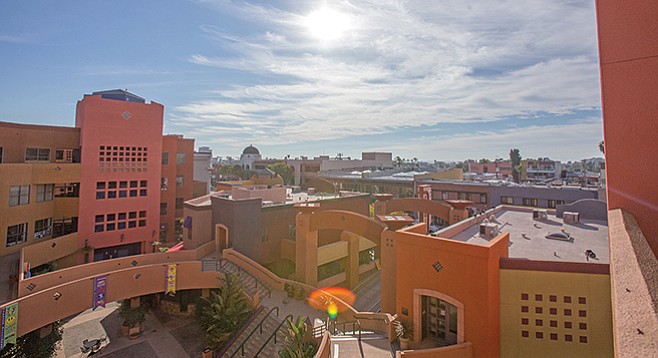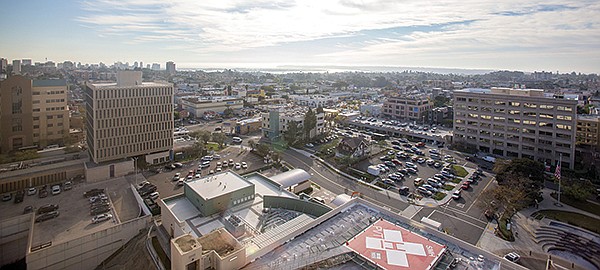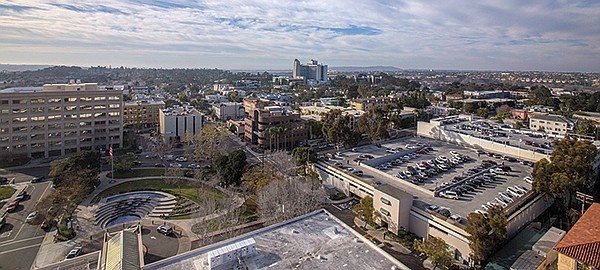 Facebook
Facebook
 X
X
 Instagram
Instagram
 TikTok
TikTok
 Youtube
Youtube

A group of property owners in Hillcrest want the freedom to build higher residential and commercial buildings. And if that freedom isn’t granted, members of the newly formed Uptown Gateway Council warn, local housing prices will continue to climb and people will move to outlying areas. The group also claims inaction will steer the city further from addressing climate change and do little to solve affordable-housing shortages.
In order to prevent such societal ills, the group is asking for their own zoning district in Hillcrest where current and proposed density and height requirements don’t apply. In the proposed district, developers would be allowed build up to 200-feet high — 135 feet higher than currently allowed — and build one unit per 200 square feet of lot size, more than double the amount of density currently proposed in areas of Hillcrest.

Former Development Services Department director Marcela Escobar-Eck represents the Uptown Gateway Council, which includes Hillcrest’s largest property owners, Gary Pernicano, Bennet Greenwald, Charlie Jadallah, as well as nine others.
Altogether the property owners own 7.13 acres of property in the heart of Hillcrest. They say the city’s zoning plans for the community, as proposed in the updated community plan, only shows the “disconnect” between the developers and the city’s stringent building restrictions.
Hillcrest residents and developers have clashed over increased density and height limits for nearly a decade. Until now, residents have won the battle, having convinced the city council to adopt an interim height limit that capped building heights at 50 to 65 feet in portions of Hillcrest and Mission Hills.
But the height limit will change when the update to Uptown’s Community Plan is ratified. In their draft update, city planners have chosen to increase building heights to 100 feet.
That proposal isn’t good enough for the Uptown Gateway Council. Escobar-Eck is lobbying planners and elected officials to increase heights to 200 feet along commercial corridors. The proposal once again pits developers and commercial property owners against residents.

The debate over height limits and density in Uptown communities, say some housing advocates, is much more than another NIMBY-versus-developer spat: it is an argument about affordable housing and getting closer to more public-transit-dependent communities. As long as development is spurred, they argue, rents will continue to climb in Hillcrest. Middle- and low-income families will be pushed out from Uptown, further away from jobs, all while increasing their dependence on vehicles.
In a December 1 letter to the city’s planning department, Escobar-Eck, on behalf of the group, warned city planners that succumbing to residents’ protests does more harm than good. Escobar-Eck urged the city to create a district within a district where they can build up to 200 feet high in certain areas and double the density from 45 to 73 units per acre to 100 units per acre.
“It is fundamental to understand that the economics of real estate development dictate that goals for a more livable community are, frankly, unachievable without the flexibility to develop higher and denser projects,” Escobar-Eck wrote. “…We cannot just stand still and wait for the rug to be pulled from under them, and with it their property values, dreams, and aspirations for a better Uptown.
“This draft plan does not accomplish what we anticipate all residents and property owners of Uptown would desire: the activation of streets with people, commerce, and entertainment. There is a disconnect in this draft plan, in that somehow this activation can be realized while simultaneously diminishing the height and density of future projects. The key to activation of the ground plane and to increasing the public realm is to build higher and denser....
“Lowering density creates an economic productivity issue. Diminishing, rather than enhancing the economic productivity of this area ultimately translates into a regional failure. The net result of the draft plan as written is that new development doesn’t work and not much will change for the better, this in an area where as you have been notified, economic activity is currently scaling down. If not much is built or rehabilitated, this makes the city worse. Maintaining some sort of Uptown ‘status quo,’ or creating something even less than the status quo, is a stab in the heart of economic productivity.”
The proposal has angered some residents. They say this is a push for larger returns on developers’ investments and a ploy to prevent city planners and city staff from designating Hillcrest’s business center, where most of the gateway proposal is located, as a historic site.
“The owners are trying to get their way with zoning in general, and are especially trying to stop the establishment of a Hillcrest historic district the city has recommended since 1981 for the area where their properties are located,” says Uptown planner Mat Wahlstrom. “[Adopting this proposal] would destroy the very quality of life that makes people want to build here in the first place.”
But what about affordable-housing shortages and rising rental rates? If the city wants to move closer to their “city of villages” vision, where residents live in mixed-use developments and walk, bike, and use transit to get around, don’t building restrictions make it harder for that to occur?
“The ‘Gateway Gang’ are not advocating affordable housing,” Wahlstrom counters, “they are pushing speculative development of luxury condos for all the money they can get.... Property values increase when density is increased and only the rich can afford it. That’s why there’s sprawl. Increased density allows more units per lot, which means greater potential income; greater potential income increases value, which increases costs to developers — who pass the expense on to buyers.”
Wahlstrom has formed a group called Rescue Hillcrest to fight the Gateway district.
One only needs to look at the current housing climate in Hillcrest, says cycling advocate and blogger Paul Jamason, to see that it is the middle- and lower-class residents in need of rescue.
“Blocking new housing has already changed the community character in a negative way, by making it difficult for anyone but wealthier residents to live in Hillcrest. Communities naturally change over time, and many people oppose change. Residents complained when historic bungalows were built because they ruined open fields. Cryogenically preserving 1970s-era strip malls to ‘respect the scale of our neighborhood’ is short-sighted.”
Adds Jamason, “Established residents have profited greatly from huge home-equity increases as prices soar. These profits are partly due to anti-housing policies like the Interim Height Ordinance. Now residents are tripling down with downzoning and the Hillcrest historical district. These are exclusionist zoning measures that boost homeowner profits while increasing inequity for younger San Diegans — in a ‘progressive’ neighborhood, no less.”
Leo Wilson, a longtime community planner in Uptown, disagrees. “I am not aware of any of the recent tall buildings built in Uptown as affordable; in fact, they are expensive luxury units.”
Two current listings in the nearly 150-foot-tall Park One tower at the north end of Balboa Park on Sixth Avenue seem to confirm this contention. Both units feature two bedrooms and 2.5 bathrooms and offer 2280 square feet of living space. The second-floor condominium is listed at $999,999 and the ninth-floor unit at $1,499,000. Both are well above the $654,700 that Zillow.com says is the median home price for Hillcrest’s 92103 zip code.
“[Developers] are actually demolishing the more affordable units in older buildings to make room for more expensive high-end units in taller buildings,” continues Wilson. “What is taking place is gentrification, not the provision of more affordable housing. Given the high cost of new housings built in Uptown, my impression has been the newcomers are more wealthy than the existing resident.”
Marcela Escobar-Eck did not respond to a request to comment.


A group of property owners in Hillcrest want the freedom to build higher residential and commercial buildings. And if that freedom isn’t granted, members of the newly formed Uptown Gateway Council warn, local housing prices will continue to climb and people will move to outlying areas. The group also claims inaction will steer the city further from addressing climate change and do little to solve affordable-housing shortages.
In order to prevent such societal ills, the group is asking for their own zoning district in Hillcrest where current and proposed density and height requirements don’t apply. In the proposed district, developers would be allowed build up to 200-feet high — 135 feet higher than currently allowed — and build one unit per 200 square feet of lot size, more than double the amount of density currently proposed in areas of Hillcrest.

Former Development Services Department director Marcela Escobar-Eck represents the Uptown Gateway Council, which includes Hillcrest’s largest property owners, Gary Pernicano, Bennet Greenwald, Charlie Jadallah, as well as nine others.
Altogether the property owners own 7.13 acres of property in the heart of Hillcrest. They say the city’s zoning plans for the community, as proposed in the updated community plan, only shows the “disconnect” between the developers and the city’s stringent building restrictions.
Hillcrest residents and developers have clashed over increased density and height limits for nearly a decade. Until now, residents have won the battle, having convinced the city council to adopt an interim height limit that capped building heights at 50 to 65 feet in portions of Hillcrest and Mission Hills.
But the height limit will change when the update to Uptown’s Community Plan is ratified. In their draft update, city planners have chosen to increase building heights to 100 feet.
That proposal isn’t good enough for the Uptown Gateway Council. Escobar-Eck is lobbying planners and elected officials to increase heights to 200 feet along commercial corridors. The proposal once again pits developers and commercial property owners against residents.

The debate over height limits and density in Uptown communities, say some housing advocates, is much more than another NIMBY-versus-developer spat: it is an argument about affordable housing and getting closer to more public-transit-dependent communities. As long as development is spurred, they argue, rents will continue to climb in Hillcrest. Middle- and low-income families will be pushed out from Uptown, further away from jobs, all while increasing their dependence on vehicles.
In a December 1 letter to the city’s planning department, Escobar-Eck, on behalf of the group, warned city planners that succumbing to residents’ protests does more harm than good. Escobar-Eck urged the city to create a district within a district where they can build up to 200 feet high in certain areas and double the density from 45 to 73 units per acre to 100 units per acre.
“It is fundamental to understand that the economics of real estate development dictate that goals for a more livable community are, frankly, unachievable without the flexibility to develop higher and denser projects,” Escobar-Eck wrote. “…We cannot just stand still and wait for the rug to be pulled from under them, and with it their property values, dreams, and aspirations for a better Uptown.
“This draft plan does not accomplish what we anticipate all residents and property owners of Uptown would desire: the activation of streets with people, commerce, and entertainment. There is a disconnect in this draft plan, in that somehow this activation can be realized while simultaneously diminishing the height and density of future projects. The key to activation of the ground plane and to increasing the public realm is to build higher and denser....
“Lowering density creates an economic productivity issue. Diminishing, rather than enhancing the economic productivity of this area ultimately translates into a regional failure. The net result of the draft plan as written is that new development doesn’t work and not much will change for the better, this in an area where as you have been notified, economic activity is currently scaling down. If not much is built or rehabilitated, this makes the city worse. Maintaining some sort of Uptown ‘status quo,’ or creating something even less than the status quo, is a stab in the heart of economic productivity.”
The proposal has angered some residents. They say this is a push for larger returns on developers’ investments and a ploy to prevent city planners and city staff from designating Hillcrest’s business center, where most of the gateway proposal is located, as a historic site.
“The owners are trying to get their way with zoning in general, and are especially trying to stop the establishment of a Hillcrest historic district the city has recommended since 1981 for the area where their properties are located,” says Uptown planner Mat Wahlstrom. “[Adopting this proposal] would destroy the very quality of life that makes people want to build here in the first place.”
But what about affordable-housing shortages and rising rental rates? If the city wants to move closer to their “city of villages” vision, where residents live in mixed-use developments and walk, bike, and use transit to get around, don’t building restrictions make it harder for that to occur?
“The ‘Gateway Gang’ are not advocating affordable housing,” Wahlstrom counters, “they are pushing speculative development of luxury condos for all the money they can get.... Property values increase when density is increased and only the rich can afford it. That’s why there’s sprawl. Increased density allows more units per lot, which means greater potential income; greater potential income increases value, which increases costs to developers — who pass the expense on to buyers.”
Wahlstrom has formed a group called Rescue Hillcrest to fight the Gateway district.
One only needs to look at the current housing climate in Hillcrest, says cycling advocate and blogger Paul Jamason, to see that it is the middle- and lower-class residents in need of rescue.
“Blocking new housing has already changed the community character in a negative way, by making it difficult for anyone but wealthier residents to live in Hillcrest. Communities naturally change over time, and many people oppose change. Residents complained when historic bungalows were built because they ruined open fields. Cryogenically preserving 1970s-era strip malls to ‘respect the scale of our neighborhood’ is short-sighted.”
Adds Jamason, “Established residents have profited greatly from huge home-equity increases as prices soar. These profits are partly due to anti-housing policies like the Interim Height Ordinance. Now residents are tripling down with downzoning and the Hillcrest historical district. These are exclusionist zoning measures that boost homeowner profits while increasing inequity for younger San Diegans — in a ‘progressive’ neighborhood, no less.”
Leo Wilson, a longtime community planner in Uptown, disagrees. “I am not aware of any of the recent tall buildings built in Uptown as affordable; in fact, they are expensive luxury units.”
Two current listings in the nearly 150-foot-tall Park One tower at the north end of Balboa Park on Sixth Avenue seem to confirm this contention. Both units feature two bedrooms and 2.5 bathrooms and offer 2280 square feet of living space. The second-floor condominium is listed at $999,999 and the ninth-floor unit at $1,499,000. Both are well above the $654,700 that Zillow.com says is the median home price for Hillcrest’s 92103 zip code.
“[Developers] are actually demolishing the more affordable units in older buildings to make room for more expensive high-end units in taller buildings,” continues Wilson. “What is taking place is gentrification, not the provision of more affordable housing. Given the high cost of new housings built in Uptown, my impression has been the newcomers are more wealthy than the existing resident.”
Marcela Escobar-Eck did not respond to a request to comment.
Comments